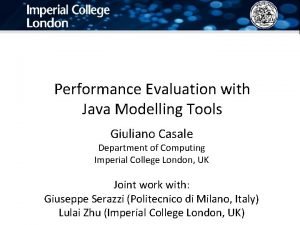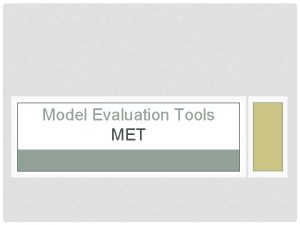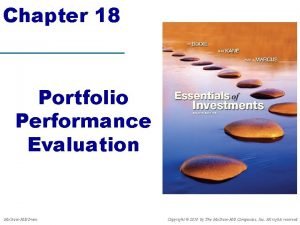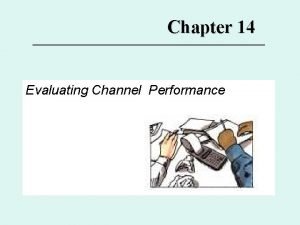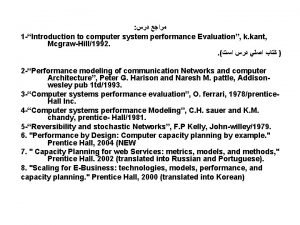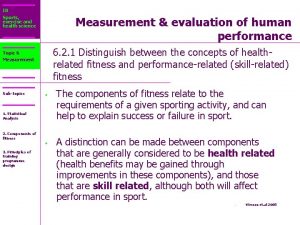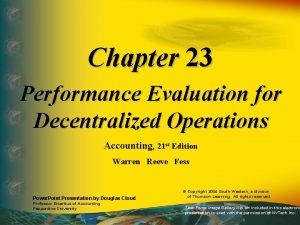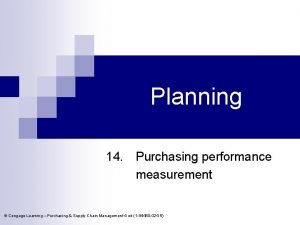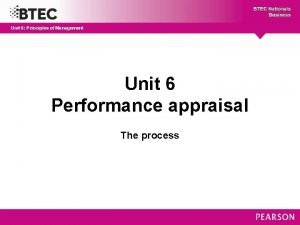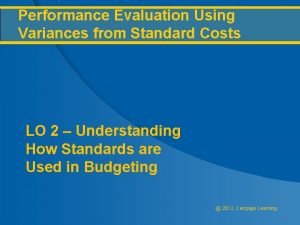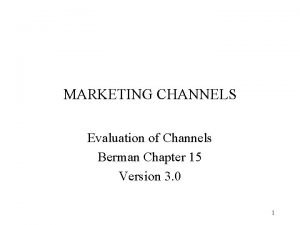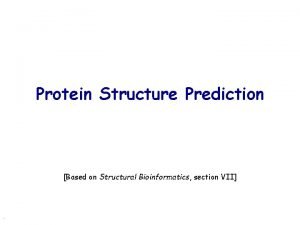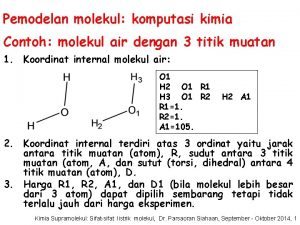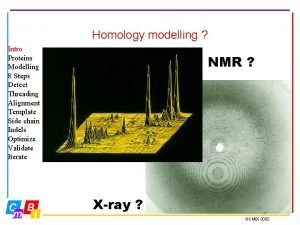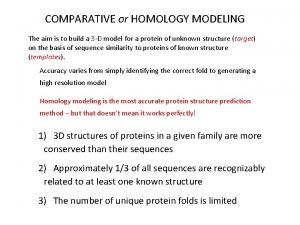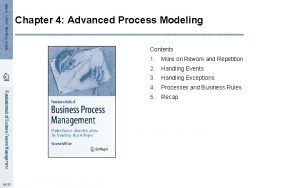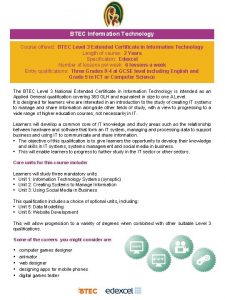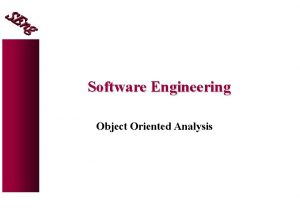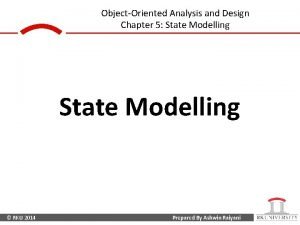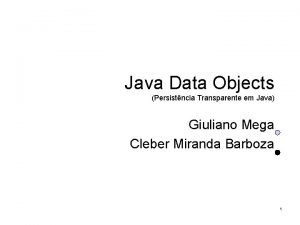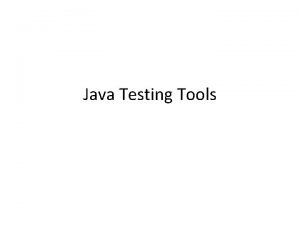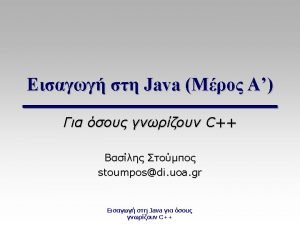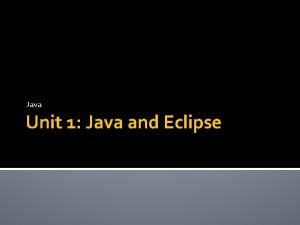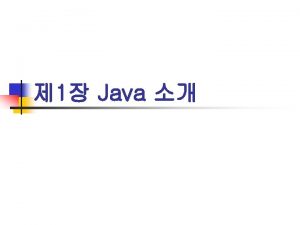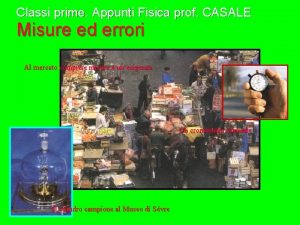Performance Evaluation with Java Modelling Tools Giuliano Casale




























































- Slides: 60

Performance Evaluation with Java Modelling Tools Giuliano Casale Department of Computing Imperial College London, UK Joint work with: Giuseppe Serazzi (Politecnico di Milano, Italy) Lulai Zhu (Imperial College London, UK)

Outline Introduction Activity 1: getting started Activity 2: load balancing Activity 3: parameter sweeping Activity 4: capacity constraints Activity 5: workflows & fork-join Please download the latest JMT (v 1. 0. 2) here: http: //jmt. sf. net/Download. html 2

Introduction

Java Modelling Tools Simulation and analysis of queueing networks. Project started in 2002 at Politecnico di Milano, since 2010 co-developed at Imperial. JMT is open source: GPL v 2, Medium-size project: ~1, 000 classes JAR, source code and maven build files (pom. xml) http: //jmt. sourceforge. net/Download. html Good diffusion (59 k downloads, mostly from the US) Community interaction mainly through Bug reports Feature requests Templates 4

Supported models Queueing Systems Queueing Networks (QN) Product-form Extended (fork/join, blocking, priorities, …) Petri Nets (PN) Stochastic Petri Nets (SPN) Generalized Stochastic Petri Nets (GSPN) Coloured Petri Nets (CPN) Queueing Petri Nets (QPNs) 5

Who uses JMT? • JMT is for PE practice, teaching, and research • Several university courses worldwide (tell us!) • Supporting materials available on website 6

JMT Start Screen Simulator 7

JSIMgraph: QN & PN simulation 8

Templates 9

JSIMwiz: wizard-based user interface 10

JSIMengine: discrete-event simulator Simulation components defined by 3 sections external arrivals (open class) component sections queueing station Discrete-event simulation of section messaging serve admit route complete 11

JSIMengine: JMT architecture (also stores results) CLI / XML GUI JABA, JMVA, JWAT XML JMT framework JSIMwiz XSLT JSIMgraph XML Status Update JSIMengine 12

JMVA: analytical solver Analysis of product-form queueing networks Several exact and approximate algorithms Exact MVA • Reiser & Lavenberg O(NR) • Load-dependent O(N 2 R) Normalizing constant • RECAL O(NM) • Co. M O(Nlog. N) Approximate MVA O(1) • • • Chow Bard-Schweitzer AQL Linearizer De Souza-Muntz N: jobs M: stations R: classes 13

JMVA: model parameterization 14

JMVA: solutions Choice of solution algorithm 15

JABA: bottleneck identification bottlenecks Common saturation sector Fraction of class 2 jobs that saturate two resources concurrently 16

JABA: bottleneck identification 3 -class model Service demands of class 2 bottlenecks Service demands of class 1 17

JMCH: Markov chain animation 18

JWAT: workload characterization Column-Oriented Log File Specify Format Data Format Templates G. Casale – G. Serazzi Load Data 19

JWAT: workload characterization Scatter plots c=std. dev. /mean Histogram Hyper-Exp (c >1) 20

Activity 1: getting started

Hands-on activity: M/M/1 Arrival rate: λ=0. 5 job/s (Exponential) Service rate: µ=1. 00 job/s (Exponential) Goal: verify M=>M property 22

Class definition Open, closed, and mixed workloads Priorities and reference stations Reference station for closed class Reference station for open class Reference stations used for system metrics Visits at node = TPUTnode/TPUTref is the reference station 23

Arrival distribution Time-Varying Peaks of User Activity Will the system sustain the load? High Performance Sun Mon Tue Wed Thu 24

Queue section Non-preemptive scheduling: FCFS, LCFS, RAND, SJF, LJF, SEPT, LEPT, HOL (FCFS priority) Preemptive scheduling: PS, GPS, DPS Buffer size 25

Service section number of servers exponential rate = 0. 5 26

Service time distribution External trace Service time 27

Perf. Indices 19 types of performance indices Utilization, residence time, response time Throughput, firing rates, drop rates, … Granularity: system, station, class, mode, sink 28

Sim. Results performance indices confidence interval transient duration the number of samples needed is greater than the max allowed actual sim. parameters default values of parameters 29

Statistical analysis Automated (overridable) simulation stop maximum relative error confidence level 30 traditional control parameters 30

Transient filtering Intelligent filtering of simulation data R 5 heuristics, spectral analysis, MSER-5 rule, . . . [Spratt, M. S. Thesis, 1998] Transient [Pawlikowski, CSUR, 1990] (Steady State) [Heidelberger&Welch, CACM, 1981] 31

Detailed statistical results Response time percentiles, buffer overflow probability, departure process moments, … 32

Loggers Simulation events can be traced in CSV files logger global. csv job id (same throughout simulation) job class 33

Activity 2: Load balancing

Routing section or …. Probabilistic routing State-dependent routing: JSQ, SRT, LU, FS Load-dependent probabilistic routing 35

… router node Router node also allows to specify routing Applies policy across multiple input queues Same policies as routing section 36

Hands-on activity: load balancing We add two queues to the M/M/1 model. Goal: compare round-robin and probabilistic load-balancing 37

Blocking after service station with finite capacity selection of the BAS policy max number of requests in the station BAS policy: requests are blocked in the sender station when the max capacity of the receiver is reached 38

Activity 3: Parameter sweeping

Hands-on activity: bottleneck switch Analysis of bottleneck switch Measure: Number of Customers Demands: Queue 1: 10 , 5; Queue 2: 5 , 9 40

What-If analysis Perform repeated executions automatically 10 JSIM invocations 41

JMVA: What-If Common Saturation Sector system 0. 0181 job/ms system class 1 Common Saturation Sector Throughput 5. 5 ms equiload class 2 0. 48 class 1 Response times 42

Activity 4: Capacity constraints

FCR definition • Thread limits via finite capacity regions (FCRs) step 1 – select the components of the FCR queue drop step 2 – set the FCR region with constrained number of customers 44

FCR parameters • Capacity constraints: total, per-class, per-group • Memory constraints: jobs have sizes and must fit Global job capacity Global memory capacity Memory Capacity max number of requests per class in the FCR Job Size drop the requests when the region capacity is saturated 45

FCR groups and indices • Group-specific constraints (i. e. , for subset of classes) • Dedicated performance indices

Support for PN elements Places and transitions Queueing Petri nets 47

PN sections & modes JMT design paradigm extends to PN elements Mode: a rule to activate and fire a transition 48

Hand-on activity: FCRs vs QPNs Arrival rate: λ=0. 99 job/s Service rate: µ=1. 00 job/s Goal: restrict max 1 job inside queue 49

Activity 5: Workflows & fork-join

Class-switching A job can change its class during the simulation Workflows, re-entrant lines, track path-wise perf. , … Example: re-entrant line 51

Fork-Join elements Jobs split into tasks carrying id of the parent job Support for: nested fork-joins multiple join points finite capacity between fork-join advanced policies (e. g. , quorum) JMT can compute Response time at Sink 2 only 52

Advanced fork Branch prob. : randomize no. tasks and output links Random subset: choose n-out-of-k output links Class Switch: assign new class to forked tasks 53

Advanced join Quorum: wait a subset of tasks (of the same job) Guard: like quorum but requires given class mix Scaler: join then fork again 54

Semaphore Block first N tasks forked from the same job Upon arrival of the Nth, unblock and let the other pass 55

Case Study: YARN Capacity Scheduler YARN ― Yet Another Resource Negotiator 56

Case Study: YARN Capacity Scheduler Detailed model using QPN Nested FCRs (Job. Queue, Map. Queue, Red. Queue) 14. 13% error in trace-driven simulation [D. Ardagna et al. , ICA 3 PP’ 16] 57

Case Study: YARN Capacity Scheduler Simplified model using QN Class switching between Map tasks and Reduce tasks 58

Conclusion

Coming Soon (>= version 1. 0. 3) Customer impatience Ability to parallelize JMT on multiple cores Collect samples or run what-ifs in parallel Internal simulation remains single-threaded New load-balancing policies Power of k choices SITA … Tree. MVA in JMVA for sparse networks Tutorial supported by the European Union’s Horizon 2020 research and innovation programme under grant agreement No. 644869. 60
 Giuliano casale
Giuliano casale Idrocentro casale monferrato
Idrocentro casale monferrato Casale atr
Casale atr Fondazione emanuele casale
Fondazione emanuele casale Fondazione emanuele casale
Fondazione emanuele casale Dr pasquale casale
Dr pasquale casale Sottocapitalizzazione nominale
Sottocapitalizzazione nominale Scuola notarile casale
Scuola notarile casale Dionigi il piccolo
Dionigi il piccolo Giuliano calza
Giuliano calza Bill giuliano
Bill giuliano Giuliano franzan
Giuliano franzan Giuliano limonta
Giuliano limonta Davide schinetti
Davide schinetti Difference between supervision monitoring and evaluation
Difference between supervision monitoring and evaluation Met model
Met model Characteristics of effective tools for evaluation
Characteristics of effective tools for evaluation Computer architecture performance evaluation methods
Computer architecture performance evaluation methods Portfolio performance evaluation problems
Portfolio performance evaluation problems Sales performance evaluation
Sales performance evaluation Criteria for evaluating performance of channel members
Criteria for evaluating performance of channel members Progress and performance measurement and evaluation
Progress and performance measurement and evaluation Computer system performance
Computer system performance Master brief sheet
Master brief sheet Measurement and evaluation in human performance 5e download
Measurement and evaluation in human performance 5e download Direct support professional performance evaluation
Direct support professional performance evaluation Performance evaluation for decentralized operations
Performance evaluation for decentralized operations Human performance evaluation test
Human performance evaluation test Evaluating purchasing performance
Evaluating purchasing performance Citibank performance evaluation case study
Citibank performance evaluation case study Housekeeping performance improvement plan
Housekeeping performance improvement plan Evaluation for unit 6
Evaluation for unit 6 Stronge leader effectiveness performance evaluation model
Stronge leader effectiveness performance evaluation model Evaluation in progress
Evaluation in progress Performance evaluation using variances from standard costs
Performance evaluation using variances from standard costs Library staff performance evaluation
Library staff performance evaluation Channel performance evaluation
Channel performance evaluation Performance evaluation model
Performance evaluation model Da form 7222 1
Da form 7222 1 Unm pep
Unm pep The appropriate cutting tool used in cutting fabrics
The appropriate cutting tool used in cutting fabrics Technological modelling
Technological modelling Energy based model
Energy based model Molecular modelling laboratory
Molecular modelling laboratory Modelling madness what's new
Modelling madness what's new Modeling rich interaction in hci
Modeling rich interaction in hci Lbo model case study
Lbo model case study Wire frame modeling advantages
Wire frame modeling advantages Homology modelling steps
Homology modelling steps Hair modelling
Hair modelling Embedded product development life cycle
Embedded product development life cycle Homology modelling steps
Homology modelling steps Advanced process modelling
Advanced process modelling Rotational mechanical system example
Rotational mechanical system example Flight level
Flight level Unit 5 data modelling assignment 2
Unit 5 data modelling assignment 2 What is graphical modelling tool for structured analysis
What is graphical modelling tool for structured analysis Algorithmic cost modelling
Algorithmic cost modelling Class responsibility collaborator modelling
Class responsibility collaborator modelling State modelling
State modelling Sequence diagram penarikan uang di atm
Sequence diagram penarikan uang di atm
